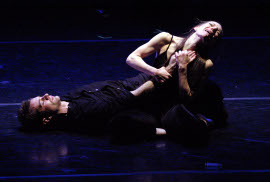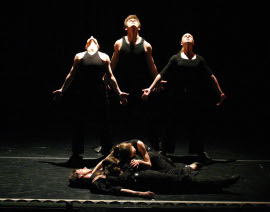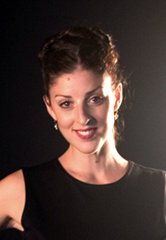 For choreographers, inspiration can sometimes come from a story, or a theme, or a series of dance moves. For Ballet Quad Cities' Margaret Huling, who makes her professional choreographic debut with the upcoming Configurations, it came from Tchaikovsky - specifically, the First Movement of the composer's Piano Trio in A Minor, Opus 50.
For choreographers, inspiration can sometimes come from a story, or a theme, or a series of dance moves. For Ballet Quad Cities' Margaret Huling, who makes her professional choreographic debut with the upcoming Configurations, it came from Tchaikovsky - specifically, the First Movement of the composer's Piano Trio in A Minor, Opus 50.
"I was kind of fighting with myself over what I wanted to do," says Huling, "and I kept coming back to the First Movement. It's music that really inspires me."
Yet choreographic inspiration can also come from the inspiration of others, as Ballet Quad Cities' Associate Director Courtney Lyon discovered in the course of re-staging original choreographer Johanne Jakhelln's Romeo & Juliet in the 21st Century.
"It's actually been one of the best experiences," she says, "because I don't feel pressured to generate an entirely new ballet. Johanne did all the hard work. [But] because it's called Romeo & Juliet in the 21st Century, giving the idea that it's current, we have to make sure it stays current." (Both Romeo & Juliet and Configurations, along with Erica Attwood's re-staging of Don Quixote's wedding pas de deux, will be performed at Davenport's Capitol Theatre on February 28 and March 1.)
 Huling, now in her fifth season with the Rock Island-based company, says that Ballet Quad Cities' Executive Director Joedy Cook approached her last summer with the idea of choreographing a piece of her own. "And I was like, 'Really?'" says Huling with a laugh. "You know, I was nervous about it, and I was kind of like, 'Oh, I don't know what to do,' but I couldn't pass up an opportunity like that."
Huling, now in her fifth season with the Rock Island-based company, says that Ballet Quad Cities' Executive Director Joedy Cook approached her last summer with the idea of choreographing a piece of her own. "And I was like, 'Really?'" says Huling with a laugh. "You know, I was nervous about it, and I was kind of like, 'Oh, I don't know what to do,' but I couldn't pass up an opportunity like that."
Helping to ease her nerves was knowing that Cook was looking for a relatively short piece (Configurations runs just over 10 minutes), plus, after flirting with the idea of a ballet set to Rachmaninov, Huling's discovery of an ideal musical selection.
Describing the appeal of Tchaikovsky's piece, Huling says, "It goes from being very fast-paced to something more intimate, and when I first heard it, I had certain steps that I really wanted to do; I could see what I wanted to do in that moment with the music, because the music just told me what I wanted to do."
With music in place, Huling says she didn't need to envision an overriding theme for her ballet, as Tchaikovsky's score was the theme. "I relied fully on the music. Most of the time when I see pieces with music and dancers, the intensity tends to build up," and like the music, says Huling, Configurations "goes the opposite. It starts with a core group of dancers moving together, and then goes down to two in the second section, and then three couples come together, and it grows into a more intimate setting.
"It's just about the form and the figures," she continues, "and making different configurations on stage, and having dancers really relate to each other."
While Huling has enjoyed the freedom to create Configurations from scratch, Lyon - a Ballet Quad Cities company member since 2000 - was given a very specific blueprint for Romeo & Juliet in the 21st Century, which debuted locally in 2003, and was re-staged in 2005.
Yet the choreographic process, she says, has been no less enjoyable, and no less demanding, for being a remount. "All of Johanne's fight scenes, I thought, were just fabulous," says Lyon. "The power of the music and the steps she put in were great; I didn't really touch those at all. But most of Romeo and Juliet's moves have changed, just because of who we now have in the roles."
 Playing the ballet's title characters for 2009 are Lyon's husband, Jake (in his seventh season with Ballet Quad Cities), and Iona Newell (in her ninth), whom Lyon offers as an example of the choreographic differences between this production and its predecessors.
Playing the ballet's title characters for 2009 are Lyon's husband, Jake (in his seventh season with Ballet Quad Cities), and Iona Newell (in her ninth), whom Lyon offers as an example of the choreographic differences between this production and its predecessors.
When Romeo & Juliet in the 21st Century was originally choreographed, says Lyon, Juliet "was in character shoes or jazz shoes. But Iona is such a lovely, soft pointe dancer - she's a technician, but she's also an artist - and jazz shoes just don't look right on her. So I took Johanne's Juliet choreography and I softened it. I rounded the edges of her movements and made the lines fit Iona's body, so the way she responds to Romeo is believable. What was believable on the dancers before, you know, doesn't necessarily work with Iona, so we softened Juliet and put her into pointe shoes, where she looks the most comfortable.
"And," she continues, "we've worked a lot on 'What are you really trying to say with this movement?' Talking through every character to make sure everything they do feels believable to the dancers, so the audience can feel it. And luckily, I felt like I had a lot of freedom to change something that wasn't working. I didn't have to try to make the dancers fit the moves."
Which, as Lyon and Huling agree, can oftentimes lead to a choreographic dead end. "For the most part, a move either works or it doesn't," says Huling. "Even if it doesn't go well the first time, you can usually tell that it's possible. But sometimes I'll be trying to sleep at night, trying to come up with different moves, and I'm like, 'Wow! That's really cool!' And then I'll see it in the studio and I'm like, 'I don't know what I was thinking!'" She laughs. "'It looked really cool in my head ... !'"
 All the more reason, then, for both Ballet Quad Cities artists to be grateful for the collaborative talents of their fellow dancers.
All the more reason, then, for both Ballet Quad Cities artists to be grateful for the collaborative talents of their fellow dancers.
"I'd always choreographed on students before," Huling says. "But getting to choreograph on professionals, and having their knowledge of movement, I was able to put the music, my ideas, and their ideas together, and it just worked out very well."
"Sometimes," says Lyon, "you just get to the point where you're like, 'I just need something that says this,' or 'I need a shape that looks like this,' and the dancer will go and do it. And then you're like, 'Yes! That was it, that was it!' And then you can go on.
"There are really no new steps in the world," she adds. "Every step's been done. It's just how you put them together. So if someone can give you, like, one thing ... . If they can give you a word, you can make a sentence."
Ballet Quad Cities' Romeo & Juliet in the 21st Century, performed alongside Configurations and the Don Quixote pas de deux, will be staged at the Capitol Theatre on Saturday, February 28 (at 7:30 p.m.) and Sunday, March 1 (at 2 p.m.). For tickets and more information, visit BalletQuadCities.com or TheCapDavenport.com.










